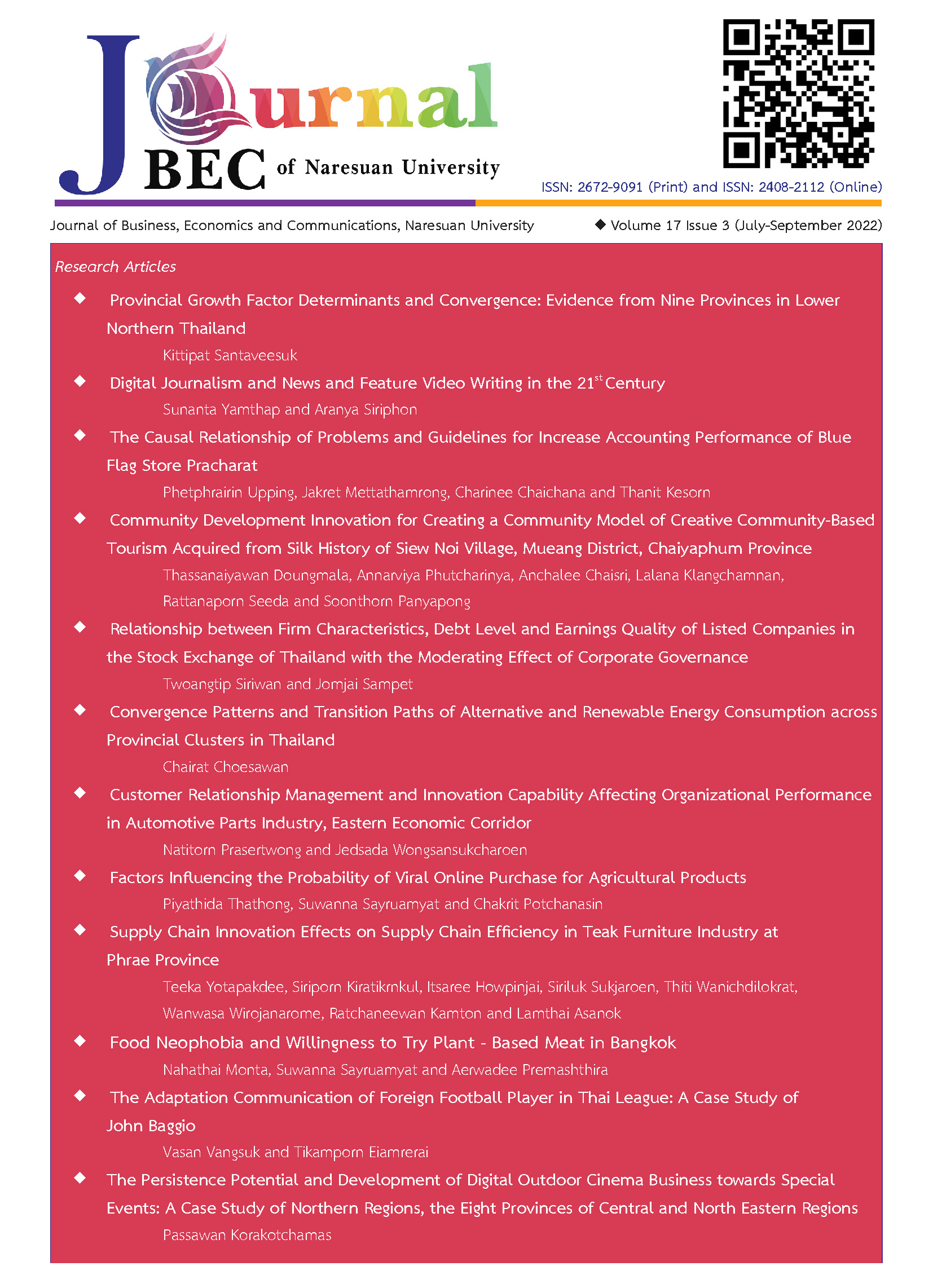Provincial Growth Factor Determinants and Convergence: Evidence from Nine Provinces in Lower Northern Thailand
Main Article Content
บทคัดย่อ
This study aims to discover the main factors that drive cross-provincial economic linkages, focusing on nine provinces in the lower northern part of Thailand. Using Solow model (1956), this involves analyzing the convergence patterns of per capital income levels and examining the core industrial clusters within this region. The findings indicate that the key drivers of economic growth in nine provinces are loans, urbanization, and labor force. Tourism spending and government expenditure are also significant but their effects are currently subtle. The analysis of economic convergence across the region confirms that integration of government policy enables the improvement of economic development within the nine provinces in accordance with the selected cluster groups for goods and services.
Article Details

อนุญาตภายใต้เงื่อนไข Creative Commons Attribution-NonCommercial-NoDerivatives 4.0 International License.
เอกสารอ้างอิง
Ansar, A., Flyvbjerg, B., Budzier, A. and Lunn, D. (2016). Does infrastructure investment lead to economic growth or economic fragility? Evidence from China. Oxford Review of Economic Policy, 32(3), 360-390.
Arellano, M. and Bond, S. (1991). Some tests of specification for panel data: Monte Carlo evidence and an application to employment equations. The review of economic studies, 58(2), 277-297.
Aziz, J. and Duenwald, C. (2003). Provincial growth dynamics. China: competing in the global economy, 30-51.
Bari, F. and Cheema, A. (2005). SME development in Pakistan analyzing the constraints to growth.
Barro, R. J. (1991). Economic growth in a cross section of countries. The quarterly journal of economics, 106(2), 407-443.
Barro, R. J. (1999). Determinants of economic growth: implications of the global evidence for Chile. Cuadernos de economía, 443-478.
Barro, R. J. and Lee, J. W. (1994, June). Sources of economic growth. In Carnegie-Rochester conference series on public policy (Vol. 40, pp. 1-46). North-Holland.
Bornhorst, Fabian and Christopher F. Baum. 2006. LEVINLIN: Stata module to perform Levin-Lin-Chu panel unit root test. Statistical software components. Retrieved May 10, 2018, from https://econpapers.repec.org/software/bocbocode/s419702.htm
Chen, J., Guo, F. and Zhu, A. (2011). The housing-led growth hypothesis revisited: evidence from the Chinese provincial panel data. Urban Studies, 48(10), 2049-2067.
Dollar, D. (1992). Outward-oriented developing economies really do grow more rapidly: evidence from 95 LDCs, 1976-1985. Economic development and cultural change, 40(3), 523-544.
Jiang, Y. (2014). Understanding TFP growth in inland regions of China: an empirical study of the effects of three factors. International Review of Applied Economics, 28(3), 365-382.
Jin, J. and Zou, H. F. (2005). Fiscal decentralization, revenue and expenditure assignments, and growth in China. Journal of Asian Economics, 16(6), 1047-1064.
Holtz-Eakin, D., Newey, W. and Rosen, H. S. (1988). Estimating vector autoregressions with panel data. Econometrica: Journal of the Econometric Society, 1371-1395.
Levin, A., Lin, C. F. and Chu, C. S. J. (2002). Unit root tests in panel data: asymptotic and finite-sample properties. Journal of econometrics, 108(1), 1-24.
Limpanonda, S. (2015). Provincial Disparities, Convergence and Effects On Poverty In Thailand. The Singapore Economic Review, 60(02), 1550015.
Mankiw, N. G., Romer, D. and Weil, D. N. (1992). A contribution to the empirics of economic growth. The Quarterly Journal of Economics, 107(2), 407-437.
Solow, R. M. (1999). Neoclassical growth theory. Handbook of macroeconomics, 1, 637-667.
Suphannachart, W. and Warr, P. (2012). 11 total factor productivity in Thai agriculture: measurement and determinants. Productivity growth in agriculture: An international perspective, 215.
Tebaldi, E. (2016). The dynamics of total factor productivity and institutions. Journal of Economic Development, 41(4), 1.
Vidyattama, Y. (2016). Inter-provincial migration and 1975–2005 regional growth in Indonesia.
Papers in Regional Science, 95, S87-S105.
Wattanakuljarus, A. and Coxhead, I. (2008). Is tourism-based development good for the poor?:
A general equilibrium analysis for Thailand. Journal of Policy Modeling, 30(6), 929-955.
Xiangfeng, L. (2007). SME development in China: A policy perspective on SME industrial
clustering. Asian SMEs and Globalization”, ERIA Research Project Report, 5.
Yue, S., and Hongyu, L. (2004). Housing prices and economic fundamentals: A cross city analysis of China for 1995—2002 [J]. Economic Research Journal, 6, 78-86.
Zhang, T. and Zou, H. F. (1998). Fiscal decentralization, public spending, and economic growth in China. Journal of Public Economics, 67(2), 221-240.


